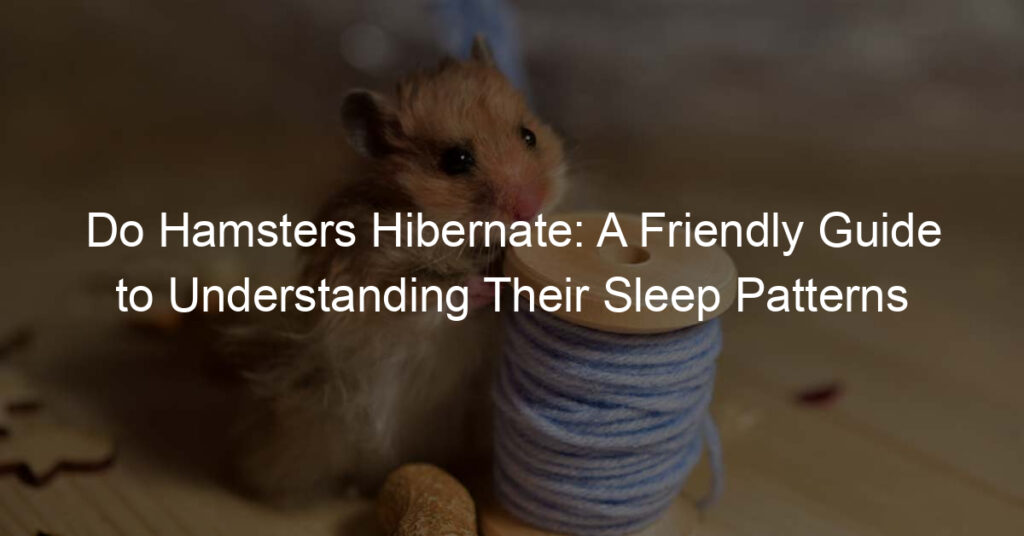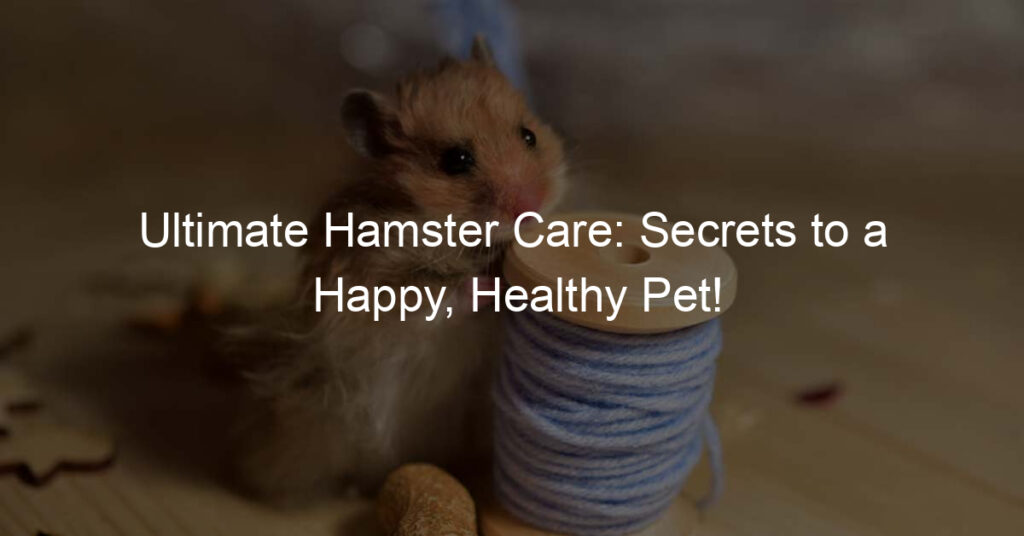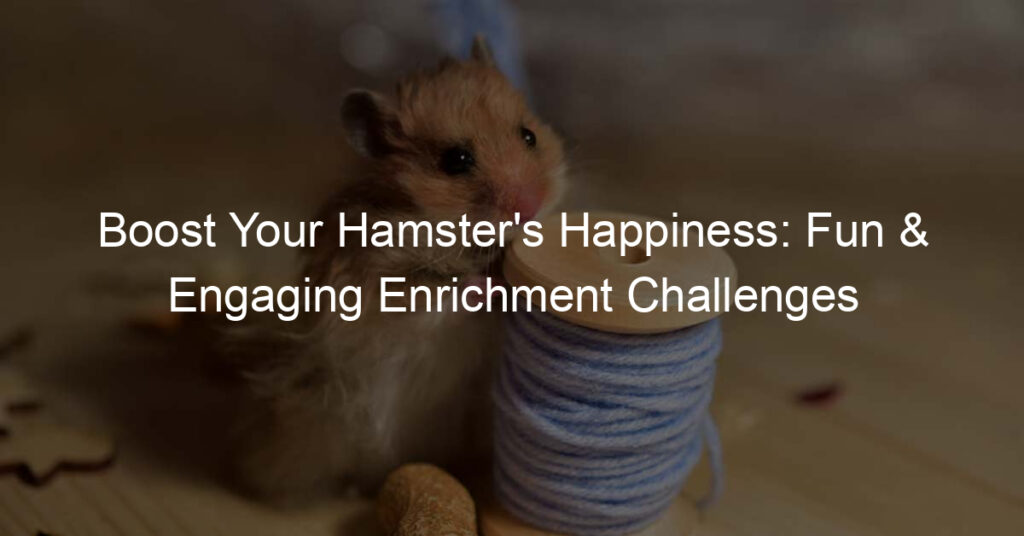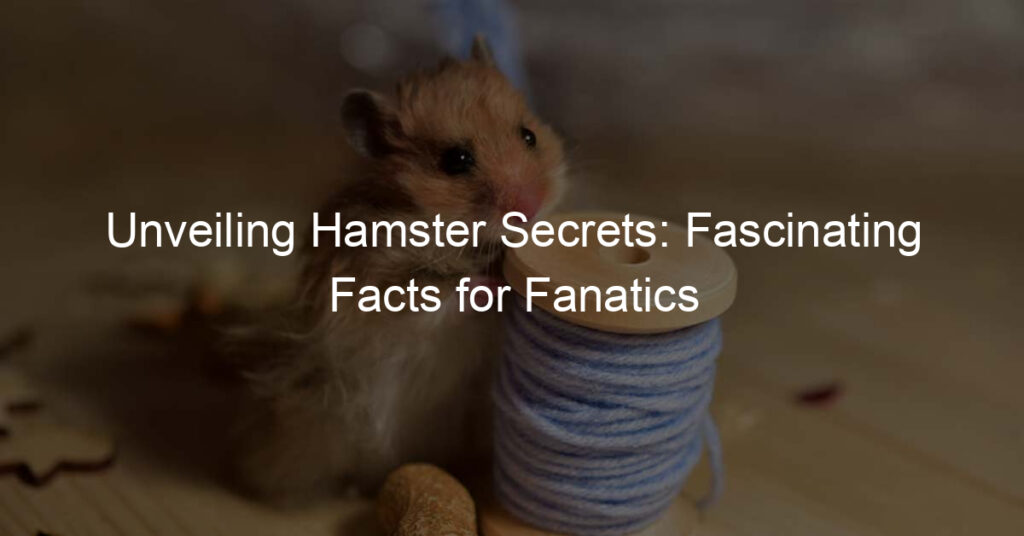Hamsters, as small and adorable pets, often spark curiosity about their natural habits and behaviors.
One question that frequently arises is do hamsters hibernate. In order to answer this, it’s essential to understand the different types of hibernation, the conditions that may trigger it, and how it can impact a hamster’s health.
While some wild hamster species do not typically hibernate due to their natural habitats lacking harsh winters, certain environmental factors may cause pet hamsters to enter a state of reduced activity called torpor or winter lethargy.
This state is not true hibernation but occurs when a hamster’s environment becomes cold or when they aren’t receiving enough food.
Some species, like European hamsters, can experience true hibernation during winter months, whereas dwarf species usually do not unless environmental conditions require it.
Key Takeaways
- Hamsters can enter a state of reduced activity called torpor or winter lethargy under cold conditions or limited food supply.
- European hamsters may experience true hibernation, while dwarf species usually do not unless necessary due to external factors.
- Recognizing the signs of hibernation and understanding how to distinguish it from death can be helpful for pet owners in managing their hamster’s health.
Understanding Hamster Hibernation
Hamsters are small pets, well-known for their cuteness and round bodies. However, many hamster owners may wonder if their furry friends hibernate like some other animals.
The truth is that not all hamsters hibernate, and their hibernation patterns differ based on their species and environmental conditions.
European hamsters show a tendency to enter obligatory hibernation. This means they will sleep for significant periods during the winter months as a natural response to the cold weather and limited food supplies.
On the other hand, dwarf hamster species are more likely to hibernate only when the environment requires it. It is interesting to note that female hamsters hibernate for shorter durations than male hamsters.
Permissive hibernators, such as hamsters, may enter a state of hibernation when faced with stressful conditions. For example, if their habitat temperature drops significantly or food resources become scarce, a hamster might decide to hibernate to conserve energy and survive the harsh conditions.
A hibernating hamster exhibits specific signs, such as binge-eating before entering hibernation due to the need for stored energy during their time in this state.
Once a hamster is hibernating, their breathing rate will slow down, and it may even appear as if they’ve stopped breathing altogether. In reality, they may be taking one breath every two minutes or so.
Additionally, their heartbeat will be faint but detectable if one gently places their fingers on the hamster’s chest.
Hamster hibernation is a fascinating adaptive behavior that varies among species and depends on environmental factors. Hibernation helps these small creatures preserve energy and survive challenging periods, so it’s essential for hamster owners to understand the signs and conditions that may prompt their pets to hibernate.
Signs of Hamster Hibernation
When it comes to hamster hibernation, it’s essential to know the signs so you can differentiate between a resting hamster and one that’s entering hibernation.
This can help you ensure your hamster’s well-being during colder months or when environmental factors trigger hibernation.
One of the first signs of hamster hibernation is a reduced appetite. Their metabolism slows down during hibernation, so they require less food. You may also notice your hamster binge eating before entering hibernation, as they stock up on nutrients for an extended period of rest.
Another sign is a significant change in their sleeping patterns. Hibernating hamsters will sleep for more extended periods than usual, with some entering a deep sleep state. During this time, they may appear very still and lethargic.
It’s vital to observe your hamster’s breathing to understand if they’re hibernating. Their breathing rate will slow down significantly, with some hamsters taking as little as one breath every two minutes. Watch closely for several minutes to confirm this change in breathing.
Checking for signs of life is crucial to ensure that your hamster is hibernating and not unwell or worse. You can do this by observing their heartbeat. Hamsters in hibernation will still have a heartbeat, albeit much slower than when they’re active.
Another sign of hibernation in hamsters is twitching whiskers. When they’re asleep or hibernating, their whiskers might twitch occasionally. This small movement indicates they’re still alive but in a state of deep rest.
Finally, you may notice stiffness in your hamster’s body during hibernation, which could lead to concerns about their health. However, stiffness can be a normal part of the hibernation process, as their body undergoes changes to preserve energy.
Recognizing the signs of hamster hibernation is essential for providing appropriate care and ensuring your pet’s well-being. Look for changes in appetite, sleep, and breathing, along with other physical signs such as whisker twitching and stiffness.
Hibernation Vs Death
Hamsters are known to hibernate, especially during cold seasons. It might be challenging for a hamster owner to distinguish between a hibernating and a dead hamster as they might appear similar at first glance.
Let’s discuss the main differences between hibernation and death in hamsters.
A hibernating hamster’s body temperature lowers, but it remains slightly warm. In this state, their metabolism slows down, leading to a decreased heartbeat and breathing rate.
A hibernating hamster’s heart rate can drop to as low as 3 beats per minute, and they may breathe only once every 1-2 minutes. If you try to observe your hamster’s cheek pouch, you will notice it is still slightly warm during hibernation.
Another sign to look for is a slight twitch when you stroke the hamster’s whiskers.
On the other hand, a dead hamster will have a cold and stiff body due to rigor mortis. Rigor mortis is the stiffening of the body’s muscles after death, which usually sets in a few hours after an animal dies. A dead hamster will have no detectable heartbeat and will have a fetal position.
Touching a dead hamster will not result in any response or twitch, even if you stroke their whiskers.
To help distinguish between a hibernating and a dead hamster, you can try the following:
- Check the ambient temperature: Hamsters are more likely to hibernate if the temperature of their environment is below 20°C (68°F).
- Observe their breathing and heartbeat: A hibernating hamster will have a slow heartbeat and breathing rate. Checking for these signs will require patience and close observation.
- Responsive to touch: Gently stroking the hamster’s whiskers or body might result in a small movement if they’re hibernating. If there’s no movement or reaction, it’s more likely that the hamster has died.
Carefully observing your hamster’s vital signs and environmental factors can help you determine if they are hibernating or have unfortunately passed away.
Regardless, if you are unsure or concerned about your hamster’s well-being, it is always best to consult a veterinarian for professional advice.
Types of Hamsters And Hibernation
Hamsters are small rodents that belong to various species, each possessing unique characteristics and behaviors. One such aspect is their hibernation patterns, which tend to vary across hamster species.
European hamsters, for instance, exhibit a form of true or obligatory hibernation. They sleep for extended periods during the winter months, as this is a natural response to the changing seasons. This behavior is observed in both wild and domesticated European hamsters, and it helps them conserve energy and survive the colder months when food resources are scarce.
In contrast, Syrian hamsters hibernate only when subjected to extreme environmental changes, such as a sudden drop in temperature or shortage of food. This type of hibernation, known as permissive hibernation, is uncommon in domesticated Syrian hamsters because they usually live in stable environments.
Among the smaller species, Russian dwarf hamsters also display hibernation behaviors when exposed to unfavorable conditions. However, unlike European and Syrian hamsters, their hibernation patterns are not as well-defined or regular. Owners of Russian dwarf hamsters should pay close attention to their pets’ needs and living conditions to ensure they remain comfortable and healthy.
Dwarf hamsters, in general, including the Roborovski and the Campbell’s Dwarf hamsters, may enter hibernation when the environment necessitates it, but it is not a natural habit for them under normal circumstances. To keep your dwarf hamster from hibernating, ensure that its living quarters are always kept at a comfortable temperature and that food is always available.
Lastly, it is important to note that female hamsters, in particular, may respond differently to hibernation triggers compared to their male counterparts, as metabolic and hormonal factors come into play. It is essential to monitor and understand the unique needs of any hamster you care for, regardless of its gender or species, to provide them with the best possible environment for their well-being.
Temperature And Hibernation
Hamsters are sensitive to changes in temperature, and their environment plays a significant role in influencing their hibernation behavior. In general, hamsters do not undergo true or obligatory hibernation like some other animals.
Yet, under certain environmental conditions, specifically when the ambient temperature drops, they may enter a hibernation-like state.
When a hamster’s living environment experiences consistently lower temperatures, typically below 20 degrees Celsius, it is likely that the hamster will go into a hibernative state.
In these conditions, they conserve energy and reduce bodily functions to prepare for the cold season.
To maintain a comfortable and healthy environment for hamsters, it is essential to pay attention to the cage’s location and temperature.
Avoid placing the cage in direct sunlight or close to bright light, as this can cause overheating. Similarly, it is crucial to keep the cage away from cold drafts, air conditioning, or air vents to prevent unnecessary coldness.
The ideal temperature range for hamsters is between 20-23 degrees Celsius (68-74 degrees Fahrenheit). To ensure that a hamster’s cage remains in an optimal temperature range, one can use heating pads or a hot water bottle to provide localized heat during colder seasons.
Remember that maintaining a stable and comfortable environment for the hamster is key in preventing them from entering an unnecessary hibernation-like state.
By monitoring the room temperature and taking necessary measures, hamster owners can help keep their furry friends safe and cozy all year round.
Preventing Hamster Hibernation
Preventing hamster hibernation is essential for your pet’s overall health and well-being. To accomplish this, it is crucial to maintain a consistent temperature inside the cage, supply sufficient food and water, and ensure proper lighting conditions.
Firstly, maintaining a steady temperature in the hamster’s cage is critical. Ensure the cage is not placed near open windows, drafts, or direct sunlight, which could cause extreme temperature fluctuations.
The ideal temperature range for a hamster’s habitat is between 65 and 75 degrees Fahrenheit. Avoid using air conditioning in the room where the hamster resides, as it could lead to low temperatures that could trigger hibernation.
Next, providing a consistent food supply is vital in discouraging hibernation. Offer your hamster high-quality hamster pellets, along with fresh fruits and vegetables.
You may also introduce fatty foods occasionally, such as nuts and seeds, to help them store energy and maintain optimal health. However, be careful not to overfeed, as this can lead to obesity.
In addition to a proper diet, ensure your hamster has access to clean water at all times. Dehydration could increase the risk of hibernation, as well as other health issues. Keep water in a sipper bottle and replace it daily to prevent contamination or bacterial growth.
Proper bedding is also essential in preventing hibernation. Provide your hamster with soft, comfortable bedding material that is easy to burrow in and retains warmth.
Providing extra bedding during colder months can help regulate their body temperature, reducing the chances of hibernation.
Lastly, controlling the light exposure of your hamster can prevent the imbalanced state that leads to hibernation. Ensure your pet has at least 12 hours of strong light per day, and keep track of the daily sunlight hours if you live in an area prone to seasonal affective disorder.
Paying attention to your hamster’s cage environment, diet, and light exposure can help prevent their instinct to hibernate and ensure their continued health and happiness.
Health Concerns Related to Hibernation
Hamster hibernation can give rise to several health concerns, as their respiratory and heart rates drop, as well as their body temperature. One such concern is hypothermic shock, which occurs when a hamster’s body temperature drops too low during hibernation.
This can cause serious health issues and requires immediate attention from a veterinarian.
Dehydration is another potential complication of hamster hibernation. As a hamster’s body temperature declines and it conserves energy, its need for water can be overlooked.
This may cause dehydration, negatively affecting the overall health of the hamster. It is essential to ensure that your hamster has constant access to fresh water, even during its hibernation period.
Starvation and malnutrition are other critical factors to consider when a hamster hibernates. Due to the reduced body functions while hibernating, the hamster’s food intake decreases.
Nonetheless, if hibernation lasts for an extended period, the risk of malnutrition and starvation increases. Providing an adequate food supply and monitoring your hamster’s weight is vital to prevent these issues.
In some cases, hamsters might appear ill due to hibernation. It’s important to differentiate between a genuinely sick hamster and one that is just hibernating.
Consult with a veterinarian to ensure that you provide the appropriate care to your hamster during this time.
To mitigate these health risks, it is crucial to create a suitable environment for hamsters, ensuring they have proper temperature control, as well as access to food and water.
If you notice any unusual signs or symptoms, seeking the advice of a professional veterinarian is recommended to avoid any potential health complications.
Reviving a Hibernating Hamster
During cold winter months, some hamsters may enter a state of hibernation. In this phase, the hamster’s heart rate and breathing slow down, and they might not eat for weeks.
It can be challenging to distinguish between a dead hamster and one that is hibernating. If your hamster is hibernating and the ambient temperature rises again, you can help revive it by following these friendly tips.
First, gently increase the light in the room where the hamster’s cage is located. Natural or artificial light can slowly help trigger the hamster to come out of its hibernation state.
Next, try gently massaging your hamster. Using your fingers, apply very light pressure to the hamster’s body, being cautious not to squeeze or hurt it. This will stimulate the hamster’s muscles and circulation, which can help it wake up from hibernation.
Frequently Asked Questions
How do I know if my hamster is hibernating?
To check if your hamster is hibernating, first observe its breathing. Hibernating hamsters have a slow breathing rate and may even snore. You might need to watch closely for a few minutes to see if your hamster is still breathing.
Additionally, you can check for a heartbeat by gently placing your thumb and forefinger on the hamster’s chest and feeling for movement.
What are the signs of hamster hibernation?
Signs of hamster hibernation include limited activity, a deep sleep-like state, slow breathing, and a slower heartbeat. Hamsters may also curl up and have cold body temperatures when they are hibernating.
Do all hamster breeds hibernate?
While most hamsters are not true hibernators, certain breeds may enter hibernation-like states under specific environmental conditions.
European hamsters, for example, experience true hibernation during winter months. Dwarf hamster species do not hibernate under normal conditions but will do so when the environment requires it.
When do hamsters typically hibernate?
Hamsters typically begin hibernating when their habitat’s temperature drops below 65 degrees Fahrenheit for more than 24 hours. This often occurs during the colder winter months, but it can also happen if a room’s temperature drops below the threshold.
How long does hamster hibernation last?
Hamster hibernation duration can vary depending on factors like temperature, hamster breed, and individual needs. European hamsters and other species that experience true hibernation will do so for significant lengths of time during winter months.
Female hamsters generally hibernate for shorter periods than males.
Can hamster hibernation be dangerous?
Although hamster hibernation is a natural response to cold temperatures, it can be dangerous if not monitored properly. Prolonged hibernation can lead to dehydration, malnutrition, and even death if the hamster is not cared for adequately.
To ensure your hamster’s safety, make sure to maintain a consistent habitat temperature and watch closely for signs of hibernation so you can take appropriate action.








